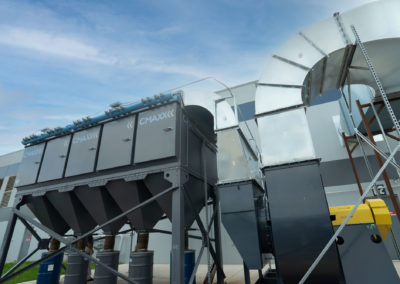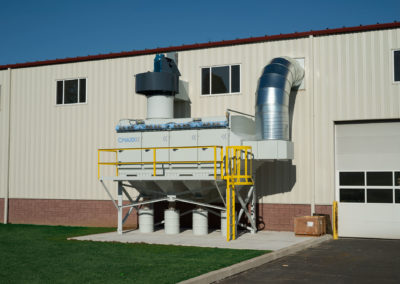Robotic Weld Cell Fume Extraction
Robotic weld cell installations become more common every year as robots take over many manufacturing tasks. While the dust and fumes may not bother the robots, you need to keep workers in the area safe. Welding cell fume extraction improves the air quality of the entire facility.

The layout of robotic weld cells needs to include access for fume extraction. Robots can decrease costs, but they can also affect air quality more than a human worker in a weld cell.
Our systems are designed to handle the dust and fumes from almost all robotic cell processes, including:
- Welding
- Grinding
- Polishing
- Deburring
- Drilling
- Cutting
HOW DO YOU IMPROVE ROBOTIC WELD CELL AIR QUALITY?
While robotics are changing the entire industry, they pose new challenges in the design and layout of robotic welding cells in the facility.
Protection from these weld cell fumes requires an air filtration system that can adapt to the unique challenges of robotic weld cell safety. The cost of robotic spot welders and other automated equipment means that your dust and fume collector has to protect these expensive items from damage.
WHAT KIND OF DUST AND FUME COLLECTOR WORKS WITH ROBOTIC WELD CELLS?
You have options for how to control fumes from your robotic cells. Often, these options will also work to protect welding cells where humans work.
For some applications, a larger outdoor dust and fume collector like the CMAXX will provide improved air quality. Depending on the facility design, this may require a lot of ductwork to provide filtration to all the cells.
For other applications, smaller indoor welding fume extractors may be the cost-efficient option for your weld cell air quality. The Shadow Compact Fume Extractor has been designed for indoor use. Cost-efficient and easy to use, these small footprint systems can make it easier to provide air filtration to all your robotic weld cells.

DeltaMAXX Prime Cartridge Filters
The filters for our CMAXX and Shadow dust collectors include 400 square feet of filter media and are the most efficient filter in the industry. With a double gasket and unique pan shape not seen in any other competitor, we have designed the best filter for the best dust and fume collector on earth.
Air-Port Fume Exhaust Hood
The Air-Port Fume Exhaust Hood incorporates the duct as part of the two-legged layout for a compact design that takes up less floor space than standard four-legged designs. It is compatible with a variety of welding system manufacturers including Kawasaki Robotics, Motorman Robotics, Yaskawa, and more.
Chemical Suppression System
When a flame is detected, this system quickly disperses an explosion suppressant to keep the deflagration isolated inside the unit. This is a good option for when explosion venting is not a possibility based on the location and arrangement of the dust collector.
Spark Trap
Spark Traps are common in metalworking applications where there is concern over a spark entering the dust collector and starting a fire. A Spark Trap introduces turbulence to the airflow, knocking the spark around until it looses heat.
Rhino Drum
A Rhino Drum is a low cost, effective alternative to a rotary airlock. If the material being discharged from the dust collector is considered combustible, having a collection drum that can withstand an explosion adds another layer of safety to the system. Because sawdust, wood flour, and other wood dusts are considered combustible, a Rhino Drum is a good added safety option for these applications.
Abort Gate
An Abort Gate is typically situated on the return air side of the dust collector and protects the facility and employees in the event that a fire or explosion occurs in the unit. An Abort Gate can also be trigged by a spark detector or broken bag detector, preventing harmful material like fire and smoke from entering the building.
Explosion Venting
Explosion venting ensures that, in the unlikely event that a deflagration occurs in a dust collector, the built up pressure inside the vessel has a way to escape. Proper venting allows the event to diffuse instead of escalating into a more dangerous problem.
Explosion Isolation Valve
An Explosion Isolation Valve goes on the intake side of the unit and prevents fire from traveling back into the building in the event of a deflagration inside the collector.
Airlock
Our Airlocks maintain a consistent seal between the collection container and the dust collector while allowing material to continuously pass through. This seal also allows discarded material to be properly discharged, and prevents it from returning to the dust collector.
Fume Arms
Fume arms capture fume and particulate directly at the source. However, fume arms must be carefully positioned to work properly, and must be moved each time the welder repositions itself, or the work is repositioned.
Backdraft Table
Backdraft tables may be a good solution for facilities that are working primarily on small pieces. These tables don’t require repositioning like fume arms, and consistently pull air and debris away from personnel and equipment. They may not be suitable, however, for any larger pieces that do not fit on the table.









